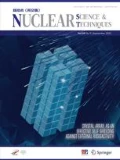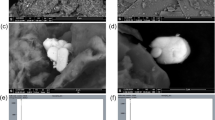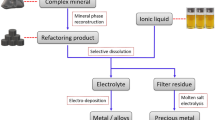Abstract
Radioactive fluoride wastes are generated during the operation of molten salt reactors (MSRs) and reprocessing of their spent fuel. Immobilization of these wastes in borosilicate glass is not feasible because of the very low solubility of fluorides in this host. Alternative candidates are thus an active topic of research including phosphate-based glasses, crystalline ceramics, and hybrid glass–ceramic systems. In this study, mixed fluorides were employed as simulated MSRs waste and incorporated into sodium aluminophosphate glass to obtain phosphate-based waste form. These waste forms were characterized by X-ray diffraction, Raman spectroscopy, and scanning electron microscopy. Leaching tests were performed in deionized water using the product consistency test A method. This study demonstrates that up to 20 mol% of simulated radioactive waste can be introduced into the NaAlP glass matrix, and the chemical durability is much better than that of borosilicate. The addition of Fe2O3 in the NaAlP glass matrix results in increases of the chemical durability at the expense of fluoride loading (to 6.4 mol%). Phosphate glass vitrification of radioactive waste containing fluorides is a potential method to treat and dispose of MSR wastes.



Similar content being viewed by others
References
B. Cai, J. Wang, L. Sun et al., Experimental study and numerical optimization on a vane-type separator for bubble separation in TMSR. Prog. Nucl. Energy 74, 1–13 (2014). doi:10.1016/j.pnucene.2014.02.007
T. Jin, X. Xiaobin, P. Chao et al., Impact analysis of criticality safety for 10-MWt solid thorium-based molten salt reactor spent nuclear fuel storage system. Nucl. Sci. Technol. 38(5), 050602 (2015). (in Chinese)
Z. Zhihong, X. Xiaobin, C. Jun et al., Simulation of radiation dose distribution and thermal analysis for the bulk shielding of an optimized molten salt reactor. Nucl. Sci. Technol. 26(4), 040603 (2015). doi:10.13538/j.1001-8042/nst.26.040603
D.D. Siemer, Molten salt breeder reactor waste management. Nucl. Technol. 185, 100–108 (2014). doi:10.13182/NT12-164
F.J. Peretz, Identification and Evaluation of Alternatives for the Disposition of Fluoride Fuel and Flush Salts from the Molten Salt Reactor Experiment. MSRE Technical Report ORNL/ER-380. (U.S. Department of Energy Office of Environmental Management, 1996), pp. 109–122
D. Day, Z. Wu, C. Ray et al., Chemically durable iron phosphate glass wasteforms. J. Non-Cryst. Solids 241(1), 1–12 (1998). doi:10.1016/S0022-3093(98)00759-5
I. Donald, B. Metcalfe, R.J. Taylor, The immobilization of high level radioactive wastes using ceramics and glasses. J. Mater. Sci. 32(22), 5851–5887 (1997). doi:10.1023/A:1018646507438
I.W. Donald, B. Metcalfe, S.K. Fong et al., A glass-encapsulated calcium phosphate wasteform for the immobilization of actinide-, fluoride-, and chloride-containing radioactive wastes from the pyrochemical reprocessing of plutonium metal. J. Nucl. Mater. 361(1), 78–93 (2007). doi:10.1016/j.jnucmat.2006.11.011
M.I. Ojovan, W.E. Lee, An Introduction to Nuclear Waste Immobilisation (Newnes Press, Amsterdam, 2005), pp. 248–249
R.K. Brow, Review: the structure of simple phosphate glasses. J. Non-Cryst. Solids 263, 1–28 (2000). doi:10.1016/S0022-3093(99)00620-1
P. Sengupta, A review on immobilization of phosphate containing high level nuclear wastes within glass matrix–Present status and future challenges. J. Hazard. Mater. 235, 17–28 (2012). doi:10.1016/j.jhazmat.2012.07.039
M. Mesko, D. Day, B. Bunker, Immobilization of CsCl and SrF in iron phosphate glass. Waste Manag 20(4), 271–278 (2000). doi:10.1016/S0956-053X(99)00331-1
X. Feng, M. Schweiger, H. Li et al, Retention of Sulfur, Phosphorus, Chlorine, and Fluorine in Hanford Phase II Vendor LLW Glasses. (American Nuclear Society, Inc., La Grange Park, IL, United States, 1996), CONF-960804–Vol.1 TRN: 97:008601
P.R. Hrma, Retention of Halogens in Waste Glass. Technical Report PNNL-19361. (Pacific Northwest National Laboratory Richland, WA, 2010), pp. 13–18
Y.G. Lavrinovich, M. Kormilitsyn, V. Konovalov et al., Vitrification of chloride wastes in the pyroelectrochemical method of reprocessing irradiated nuclear fuel. At. Energy 95(5), 781–785 (2003)
B. Tiwari, M. Pandey, V. Sudarsan et al., Study of structural modification of sodium aluminophosphate glasses with TiO2 addition through Raman and NMR spectroscopy. Phys. B 404(1), 47–51 (2009). doi:10.1016/j.physb.2008.10.016
I. Donald, B. Metcalfe, Thermal properties and crystallization kinetics of a sodium aluminophosphate based glass. J. Non-Cryst. Solids 348, 118–122 (2004). doi:10.1016/j.jnoncrysol.2004.08.136
Standard Test methods for Determining Chemical Durability of Nuclear, Hazardous, and Mixed Waste Glasses: the Product Consistency Test (PCT)
P. Bingham, R. Hand, S. Forder et al., Structure and properties of iron borophosphate glasses. Phys. Chem. Glasses B 47(4), 313–317 (2006)
H. Uwe, K. Rainer, S. Dörte et al., A neutron and X-ray diffraction study of the structure of the LaP3O9 glass. J. Non-Cryst. Solids 232, 44–50 (1998). doi:10.1016/S0022-3093(98)00396-2
W. Miniscalco, Erbium-doped glasses for fiber amplifiers at 1500 nm. Lightwave Technol. 9(2), 234–250 (1991). doi:10.1109/50.65882
L. Zhang, R.K. Brow, A Raman Study of iron–phosphate crystalline compounds and glasses. J. Am. Ceram. Soc. 94(9), 3123–3130 (2011). doi:10.1111/j.1551-2916.2011.04486.x
J.J. Hudgens, R.K. Brow, D.R. Tallant et al., Raman spectroscopy study of the structure of lithium and sodium ultraphosphate glasses. J. Non-Cryst. Solids 223(1), 21–31 (1998). doi:10.1016/S0022-3093(97)00347-5
T. Kasuga, Y. Abe, Calcium phosphate invert glasses with soda and titania. J. Non-Cryst. Solids 243(1), 70–74 (1999). doi:10.1016/S0022-3093(98)00820-5
H. Liu, J. Ma, J. Gong et al., The structure and properties of SnF2–SnO–P2O5 glasses. J. Non-Cryst. Solids 419, 92–96 (2015). doi:10.1016/j.jnoncrysol.2015.03.040
J.K. Christie, R.I. Ainsworth, N.H. de Leeuw, Ab initio molecular dynamics simulations of structural changes associated with the incorporation of fluorine in bioactive phosphate glasses. Biomaterials 35(24), 6164–6171 (2014). doi:10.1021/jp110788h
EJ/1186-2005: Characterization of radioactive waste forms and packages. 2005: 9. (In Chinese)
M. Karabulut, G. Marasinghe, C. Ray et al., An investigation of the local iron environment in iron phosphate glasses having different Fe(II) concentrations. J. Non-Cryst. Solids 306(2), 182–192 (2002). doi:10.1016/S0022-3093(02)01053-0
U. Hoppe, M. Karabulut, E. Metwalli et al., The Fe–O coordination in iron phosphate glasses by x-ray diffraction with high energy photons. J. Phys. Condens. Matter 15(36), 6143 (2003)
G.F. Piepel, T.E. Jones, D.L. Eggett et al. Product Consistency Test Round Robin Conducted by the Materials Characterization Center: Summary Report. (Pacific Northwest Laboratory, 1989), pp. 20–21
C.M. Jantzen. Engineering Study of the Hanford Low Activity Waste (LAW) Steam Reforming Process (U). (2002), p. 135
Author information
Authors and Affiliations
Corresponding author
Rights and permissions
About this article
Cite this article
Sun, YP., Xia, XB., Qiao, YB. et al. Properties of phosphate glass waste forms containing fluorides from a molten salt reactor. NUCL SCI TECH 27, 63 (2016). https://doi.org/10.1007/s41365-016-0059-9
Received:
Revised:
Accepted:
Published:
DOI: https://doi.org/10.1007/s41365-016-0059-9




